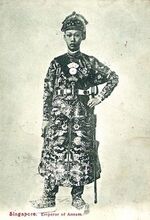Phạm dynasty: Difference between revisions
Jump to navigation
Jump to search
BattlerNonna (talk | contribs) mNo edit summary |
BattlerNonna (talk | contribs) m (Updated temple name of Duc Khenh) |
||
| Line 62: | Line 62: | ||
|- | |- | ||
| [[File:Puyi-Manchukuo.jpg|150px]] || [[Đức Khểnh]] || | | [[File:Puyi-Manchukuo.jpg|150px]] || [[Đức Khểnh]] || Triệu Tông || Phạm Nguyên Kham Quốc || Thể Thiên Xương Vận Chí Hiếu Thuần Đức Văn Vũ Minh Đoán Sáng Thuật Đại Thành Hậu Trạch Phong Công Nhân Hoàng Đế || 1931{{snd}}1945 || Promoted fascistic and militaristic values as per the endorsement from the [[Golden Nation Party]], appointed [[Lý Học Thao Viên]] as Prime Minister, enacted mass conscription laws during the [[Siduri War]], abdicated in 1945 as demanded by leaders of the [[Blue Headband Revolution]] | ||
|- | |- | ||
Revision as of 22:10, 17 May 2021
| Phạm dynasty Triều Phạm | |
|---|---|
Imperial seal of the Dynasty | |
Imperial standard of the Dynasty | |
| Parent family | Phạm lords |
| Country | |
| Founded | January 1, 1860 |
| Founder | Bảo Thịnh |
| Current head | Lành Chinh |
| Titles | Emperor of Quenmin |
| Traditions | Haimeism |
| Cadet branches | 58 cadet houses |
The Phạm dynasty (Quenminese: Triều Phạm), also known as the House of Phạm and the Phạm clan, is the ruling dynasty of Quenmin. They trace their lineage to the feudal Phạm lords that rose to prominence during the latter half of the Kiếm Hoà Dynasty, and consequently made members of the Lận dynasty's royal court. The dynasty's founding occurred on 1 January 1860 as Bảo Thịnh ascended the imperial throne in Cao Khoát. The dynasty's incumbent head is Lành Chinh, Quenmin's fifth emperor.
Background
Emperors
The below list contains each emperor's era name, temple name, personal name and posthumous name. Despite era names serving as official identifiers instead of temple names, the latter was still bestowed upon in accordance with tradition.
| Portrait | Era Name | Temple Name | Personal Name | Posthumous Name | Reign | Notes |
|---|---|---|---|---|---|---|
 |
Bảo Thịnh | Duệ Tổ | Phạm Nguyên Ưng Thoại | Liệt Minh Uyên Thuần Văn Chượng Chương Đức Chí Kiện Đôn Lược Duệ Nhân Hoàng Đế | 1860 – 1901 | Unified Quenmin and rapidly modernized the country politically, economically and socially, abolished feudalism, founded the dynasty |
 |
Xuất Nghìn | Hiến Tông | Phạm Nguyên Quý Kế | Hoằng Liệt Thống Thiết Mẫn Huệ Thuần Hoàng Đế | 1901 – 1931 | Democratized government that transitioned the monarchy from absolute to constitutional one, further enhanced Quenmin's status as a world power, died of polio |
 |
Đức Khểnh | Triệu Tông | Phạm Nguyên Kham Quốc | Thể Thiên Xương Vận Chí Hiếu Thuần Đức Văn Vũ Minh Đoán Sáng Thuật Đại Thành Hậu Trạch Phong Công Nhân Hoàng Đế | 1931 – 1945 | Promoted fascistic and militaristic values as per the endorsement from the Golden Nation Party, appointed Lý Học Thao Viên as Prime Minister, enacted mass conscription laws during the Siduri War, abdicated in 1945 as demanded by leaders of the Blue Headband Revolution |
 |
Ngày Mừng | Định Tông | Phạm Nguyên Trường Vĩnh | Thiệu Đức Chí Hiếu Uyên Duệ Nghị Hoàng Đế | 1945 – 1973 | Staunch anti-communist, assented removal of Prime Minister Thạch Liễng Chánh and proliferated authoritarianism, granted emergency powers to Prime Minister Đỗ Kim Ngữ after Nguyễn Công Thịnh Bảo's assassination, abdicated in 1973 from the consequences of the uprisings during the same year |
 |
Lành Chinh | — | Phạm Nguyên Bửu Thuật | — | 1973 – present | Dissolved institutions created during his father's reign, assented removal of Prime Minister Nguyễn-Thạch Sĩ Chiến as per the Pagayabas Scandal, bestowed executive powers as per the Omnibus Reform Bill of 1999 |